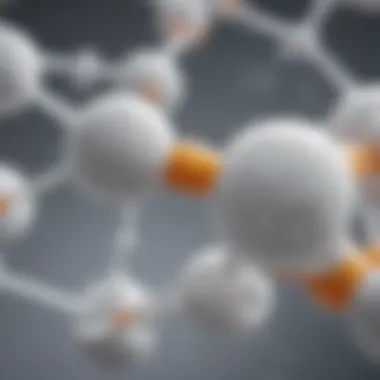Exploring Applications of Polytetrafluoroethylene


Intro
Polytetrafluoroethylene, better known as PTFE, has transcended its initial perception as a mere non-stick coating. This polymer is extensively utilized across various sectors due to its unique properties. It possesses a high tolerance to extreme temperatures, remarkable chemical resistance, and excellent insulating characteristics. These factors make PTFE invaluable in many applications, ranging from heavy industrial use to everyday consumer products. Understanding the breadth of PTFE's applications not only provides insight into its functional benefits but also emphasizes its role in advancing technology and improving safety standards in numerous fields.
Key Concepts
Definition of the Main Idea
Polytetrafluoroethylene is a synthetic fluoropolymer of tetrafluoroethylene, characterized by its high-performance features. As a polymer, it consists of long chains of carbon atoms, each bonded to fluorine atoms. This configuration grants PTFE its low surface energy, leading to effective non-stick properties. Its molecular structure is the cornerstone of its functionality, enabling it to withstand harsh environments without significant degradation.
Overview of Scientific Principles
A thorough understanding of PTFE requires insight into its key scientific principles. First, its high thermal stability allows it to maintain integrity in temperatures ranging from -200°C to 260°C. Second, the chemical inertness of PTFE means that it does not react with most chemicals, making it suitable for corrosive environments. Moreover, the low friction coefficient of PTFE leads to reduced wear and tear in mechanical applications, enhancing both efficiency and lifespan.
Key Properties of PTFE
- High Chemical Resistance: Suitable for a variety of industries, including chemical processing.
- Low Friction: Beneficial in applications such as bearings and seals.
- Electrical Insulation: Used in wiring and electronic components due to its dielectric properties.
- Non-Stick Surface: Ideal for cookware and appliances.
Current Research Trends
Recent Studies and Findings
Ongoing research focuses on improving the performance characteristics of PTFE and expanding its applications. Recent studies have explored the use of PTFE composites, which combine PTFE with other materials to enhance properties like strength and durability. For example, PTFE reinforced with carbon fiber provides significant improvements in mechanical performance while maintaining low friction properties.
Significant Breakthroughs in the Field
Innovative uses of PTFE in medical applications have emerged. Researchers are investigating its potential for use in implantable devices due to its biocompatibility and resistance to bodily fluids. These developments signify a growing recognition of PTFE's versatility beyond traditional applications, extending to critical areas such as healthcare and biotechnology.
"Polytetrafluoroethylene not only serves as an essential material in mechanical engineering but also opens new avenues in medicine through innovative applications."
"Polytetrafluoroethylene not only serves as an essential material in mechanical engineering but also opens new avenues in medicine through innovative applications."
The exploration of PTFE's capabilities reveals its importance as a material in both current and future applications, reinforcing its role in technologically advanced environments. As researchers continue to discover new functionalities, PTFE stands poised to influence various sectors in unprecedented ways.
Prologue to Polytetrafluoroethylene
Polytetrafluoroethylene, often abbreviated as PTFE, is a polymer that holds significant importance in various fields. This introduction aims to elucidate the foundational aspects of PTFE. Understanding these core elements enables us to appreciate its diverse applications. The chemical composition, thermal stability, and chemical resistance make PTFE a remarkable material. Its unique properties serve various industries, influencing production processes and product design.
Chemical Composition and Properties
Chemical structure of PTFE
The chemical structure of PTFE is characterized by a chain of carbon atoms, each bonded to two fluorine atoms. This configuration contributes to its non-stick properties, which are highly sought after. PTFE's strength lies in the high bond energy between carbon and fluorine, making it stable under a wide range of conditions. This stability results in PTFE being resistant to chemical reactions, ensuring its application in environments that involve harsh substances. Notably, its resilience marks PTFE as a popular choice in applications where traditional materials may fail.
Thermal stability
PTFE exhibits excellent thermal stability, maintaining its integrity at high temperatures. It can withstand temperatures up to approximately 260 degrees Celsius without losing its structural properties. This characteristic is essential for processes that involve extreme heat. The thermal resistance of PTFE assures reliability in many industrial settings, such as chemical processing and aerospace industries. Its consistent performance under thermal stress enhances its utility in applications requiring durability and longevity.
Chemical resistance
The chemical resistance of PTFE is one of its most prominent features, rendering it impervious to a wide array of corrosive agents. Whether exposed to acids, bases, or solvents, PTFE typically remains unaffected. This exceptional resilience makes PTFE indispensable in chemical processing industries, where the interaction with various substances is commonplace. The ability to resist degradation ensures safety and efficiency in processes typically fraught with risk if alternative materials were used.
Historical Development


Discovery and invention
PTFE was discovered in 1938 by Roy Plunkett who, during a refrigeration experiment, found that tetrafluoroethylene had polymerized into a white waxy solid. This unexpected event marked the beginning of PTFE's journey into various applications. The unique properties discovered soon gained recognition for their potential. The invention of PTFE led to its adoption in numerous sectors, paving the way for innovations in materials science. The ability to use PTFE in diverse settings has proven beneficial to both industry and consumers alike.
Evolution of production methods
The methods of producing PTFE have significantly evolved since its discovery. Initially, production involved complex processes that were time-intensive and costly. Over time, advancements have streamlined the synthesis and manufacturing processes, leading to increased efficiency and lower costs. The evolution includes improved polymerization techniques and the development of more accessible forms of PTFE, such as tapes and films. Such enhancements in production also enhance the scalability of PTFE applications, allowing for its widespread integration into various industries.
Industrial Applications of PTFE
Polytetrafluoroethylene (PTFE) is a versatile polymer that plays a significant role in various industrial applications. It is chosen for its unique properties, such as high chemical resistance, low friction, and thermal stability. Industries leverage these characteristics to improve efficiency, safety, and reliability in their processes. This section provides a detailed exploration of the industrial applications of PTFE, focusing on how it contributes to enhanced performance in different sectors.
PTFE in Chemical Processing
Use in reactors and piping
PTFE is widely used in chemical processing due to its impressive chemical resistance. It is often found in reactors and piping systems. The non-reactive nature of PTFE ensures that it does not contaminate the substances it transports or processes. This characteristic is crucial in industries that deal with corrosive chemicals. By using PTFE, manufacturers can assuredly maintain the integrity of their products.
Furthermore, PTFE's ability to withstand high temperatures and pressures makes it an ideal material for piping systems in chemical plants. This reliability results in reduced maintenance costs and minimizes the risk of leaks or failures. Its smooth surface also reduces friction, enhancing the flow of materials through pipes.
Impact on safety and efficiency
The safety and efficiency of chemical processes are critically impacted by the use of PTFE. The material’s thermal stability prevents degradation, which can pose hazards when dealing with volatile substances. A significant safety advantage is that PTFE does not support combustion. Therefore, it can be used in applications where fire risk is a concern.
Additionally, PTFE's low friction properties contribute to improved efficiency in chemical processing. Reduced friction in valves and pumps leads to lower energy consumption, which is an essential factor in cost management. The longevity of PTFE also means less frequent replacements, further extending operational efficiency.
Electronics and Electrical Components
Insulation applications
In the electronics industry, PTFE is commonly utilized for insulation applications. Its excellent electrical insulating properties make it suitable for high-frequency and high-voltage environments. This advantage is particularly relevant in telecommunications and aerospace where reliability is critical.
PTFE insulation also has a high dielectric strength, which means it can handle significant electrical stress without breaking down. This capability is highly beneficial in maintaining the performance and safety of electrical components. Its ability to endure extreme temperatures without losing its insulating properties further enhances its appeal in these applications.
Flexible circuit boards
The emergence of flexible circuit boards has been greatly aided by the use of PTFE. These boards require materials that not only offer good electrical performance but also flexibility. PTFE meets this need effectively. Its low weight and adaptability to various shapes allow for innovative designs, particularly in compact electronic devices.
Moreover, PTFE's thermal stability ensures that flexible circuit boards can operate in varying conditions without compromising their functionality. However, the processing of PTFE can be challenging due to its high melt viscosity, which manufacturers need to consider during production.
Aerospace and Automotive Industries
Usage in seals and gaskets
In the aerospace and automotive sectors, PTFE is widely used in seals and gaskets. The material's resistance to extreme temperatures and pressures makes it particularly valuable in these demanding environments. PTFE seals are known for their durability and reliability, which are essential for maintaining safety and performance in vehicles and aircraft.
Another advantage of using PTFE for seals and gaskets is its non-stick properties. This feature helps reduce wear and tear, ensuring that these components maintain their effectiveness over time. However, it's important to note that while PTFE is strong under compression, it can be less effective in high shear applications.
Enhancements in fuel efficiency
PTFE also contributes to enhancements in fuel efficiency within automotive systems. Its low friction properties reduce energy loss in moving parts, leading to improved fuel consumption. In the context of aerospace, PTFE can reduce drag in various components, optimizing overall performance.
The application of PTFE in seals, gaskets, and other components can lead to considerable savings in operational costs for both industries. However, as with any material, the manufacturing processes and subject matter expertise play crucial roles in maximizing these benefits.
PTFE's unique properties make it indispensable across various industrial applications, enhancing safety, efficiency, and performance in processes that require dependable materials.


PTFE's unique properties make it indispensable across various industrial applications, enhancing safety, efficiency, and performance in processes that require dependable materials.
Consumer Product Applications
Consumer product applications of Polytetrafluoroethylene (PTFE) represent a significant portion of its overall utilization. This section highlights the essential role PTFE plays in enhancing daily life through its innovative uses, mainly in kitchenware and medical devices. The benefits of PTFE in these areas extend from functionality to safety, making it a material of choice for both manufacturers and consumers.
Kitchenware
Non-stick cookware
Non-stick cookware is one of the most recognized applications of PTFE. This type of cookware features a coating that prevents food from adhering to the surface, which offers an unparalleled convenience for cooking. The key characteristic of non-stick cookware lies in its ability to reduce the need for oils or fats, promoting healthier cooking methods. The unique feature of the PTFE coating not only eases the cooking process but also simplifies cleaning, often requiring just a simple wipe with a cloth or a sponge.
However, there are advantages and disadvantages associated with non-stick cookware. While they often promote healthier meals and boost convenience, if not cared for properly, the coating can become scratched or damaged, potentially leading to flaking and the release of harmful substances. This is a significant consideration for consumers who value both performance and safety in their kitchen products.
Food safety considerations
Food safety considerations are paramount when discussing PTFE's role in kitchenware. Cookware made with PTFE is especially popular due to its non-reactive nature, which means that it does not leach harmful chemicals into food, even when heated. This key characteristic is beneficial, as it ensures that the cooking process maintains the integrity of the food's flavor and quality. Consumers can utilize PTFE cookware with the confidence that their meals are not contaminated by toxic substances.
Nonetheless, there are ongoing debates regarding the safety of PTFE at high temperatures. When exceeded, the coating can begin to break down, releasing potentially hazardous fumes. This highlights the necessity for consumers to use non-stick cookware as directed and to avoid overheating. Understanding these food safety considerations is critical for making informed decisions based on both convenience and health.
Medical Devices
Use in implants and prosthetics
PTFE is increasingly used in medical devices, particularly in implants and prosthetics. The specific aspect of PTFE in this context is its versatility and durability. The key characteristic of PTFE is its chemical resistance and inertness, which makes it suitable for long-term human use. It shows compatibility with various bodily environments, contributing significantly to the functionality and longevity of medical devices.
The unique feature of PTFE in implants is that it minimizes the risk of rejection by the body, making it a beneficial choice for manufacturers. However, a consideration for developers is the cost associated with manufacturing PTFE implants, which can be higher than other materials. Despite this, the overall benefits justify its use in many critical applications.
Bio-compatibility and safety
Bio-compatibility and safety are vital when assessing the use of PTFE in medical applications. PTFE is recognized for its exceptional bio-compatibility, meaning it does not provoke a significant immune response in the body. This characteristic makes it a favorable material for use in various medical devices, promoting patient safety and improving surgical outcomes.
Additionally, the unique feature of PTFE allows for minimal interaction with bodily tissues, which reduces the risk of inflammation or complications post-surgery. Nonetheless, despite its many advantages, some patients may still exhibit reactions, highlighting the need for careful patient evaluation prior to implant placement. Overall, understanding the bio-compatibility and safety of PTFE remains crucial as the healthcare industry further explores its potential.
Environmental Considerations
The discussion surrounding the environmental implications of Polytetrafluoroethylene (PTFE) is critical for understanding its place in contemporary applications. While PTFE offers numerous functional advantages, it is essential to also consider its sustainability and safety. This section will address the lifecycle of PTFE, the challenges associated with its recycling, health risks, and the regulatory body’s response concerning these issues. Each aspect plays a significant role in shaping future uses and innovations centered around PTFE.
Sustainability of PTFE
Lifecycle analysis of PTFE
Lifecycle analysis of PTFE involves examining the environmental impact of the material from production to disposal. This analysis often highlights the energy-intensive processes required for PTFE’s manufacture, particularly the polymerization process that takes place at high temperatures and pressures. A key characteristic of this analysis is how it emphasizes PTFE's durability and longevity, which can mitigate environmental harm in comparison to more short-lived materials.
The unique feature of PTFE is its exceptional resistance to wear and tear, which can lead to fewer replacements over time, showcasing its utility in manufacturing and consumer products. However, its enduring nature also raises concerns about accumulation in landfills, leading to environmental challenges. Evaluating the lifecycle helps stakeholders understand the trade-offs in using PTFE despite its beneficial attributes.
Recycling challenges and solutions
Despite its advantages, recycling PTFE presents significant challenges. A primary factor is its highly stable chemical structure which makes traditional recycling methods ineffective. Current solutions often include mechanical recycling or innovative chemical processes, though both come with limitations. One of the key characteristics of these challenges is the high costs related to processing and the need for specialized technology. This presents both an obstacle and an opportunity for industry players willing to invest in sustainable practices.
A unique development within this sphere involves exploring alternative uses for waste PTFE products, like transforming them into secondary raw materials for construction or other industries. The advantages of pursuing these solutions can lead to reduced environmental impact, while disadvantages may still stem from economic feasibility and technological readiness.
Health Risks and Safety
Discussion of toxicity


The discussion of toxicity surrounding PTFE primarily focuses on the potential health impacts of its degradation products, particularly perfluorinated compounds. These substances can accumulate in the environment and have been linked to various health issues. One key characteristic in this context is the long persistence of these chemicals in both human bodies and ecosystems, which raises significant public health concerns.
This aspect is critical for ensuring product safety, prompting manufacturers to reevaluate practices to minimize exposure. Although PTFE itself is considered safe at cooking temperatures, the potential risks from overheating leading to fume release must not be understated. Thus, knowledge of the toxicity surrounding PTFE forms essential part of discussions regarding its application.
Regulatory considerations
Regulatory considerations regarding PTFE are influenced by both national and international guidelines aimed at governing chemical safety. The unique feature of these regulations often involves continuous updates based on new research and findings related to health risks. For instance, agencies such as the Environmental Protection Agency (EPA) provide oversight to ensure public safety and environmental protection, which is paramount in maintaining trust among consumers and industries alike.
Challenges remain as stakeholders seek balance between the utility of PTFE in various applications and the necessity of adhering to regulations aimed at minimizing health risks. As research evolves, regulatory frameworks must also advance to adequately address emerging concerns.
"Understanding the implications of polytetrafluoroethylene's usage is vital for informed decision-making in both industrial and consumer contexts."
"Understanding the implications of polytetrafluoroethylene's usage is vital for informed decision-making in both industrial and consumer contexts."
Emerging Trends in PTFE Applications
The field of Polytetrafluoroethylene (PTFE) continues to evolve, making emerging trends essential to understanding its future applications. This section delves into recent developments that enhance PTFE’s functionality and extend its usability across various sectors. By exploring innovations in material science and looking at potential market trends, we highlight how these advancements are beneficial in ensuring PTFE maintains its relevance in a rapidly changing world.
Innovations in Material Science
Development of modified PTFE
Modified PTFE has emerged as a significant area in the study of this polymer. The modification processes often aim to improve the mechanical properties, such as tensile strength and impact resistance. This is crucial in applications where traditional PTFE may fall short. A pivotal characteristic of modified PTFE is its improved adhesion, allowing for better bonding in various industrial applications. Its popularity lies in its enhanced performance, especially in environments with extreme conditions.
A unique feature of modified PTFE is its ability to host a variety of fillers, leading to hybrid materials that retain the original chemical inertness of PTFE while augmenting other desirable properties. However, this modification may lead to certain drawbacks such as increased costs and complexity in processing, which need to be carefully managed.
Nanocomposites involving PTFE
Nanocomposites created with PTFE have gained considerable attention in recent materials research. These composites incorporate nanoparticles into the PTFE matrix to impart additional characteristics, such as increased stiffness and thermal stability. The key feature of nanocomposites is their potential for reduced weight without sacrificing performance, making them an intriguing choice for industries such as aerospace and automotive.
The unique feature of nanocomposites is their tunable properties, which can be customized by altering the type and amount of nanoparticles used. Yet, there are challenges involved, including the dispersibility of nanoparticles within the polymer matrix and the implications for manufacturing processes.
Future Outlook
Market trends and forecasts
As we look ahead, market trends indicate a promising growth trajectory for PTFE applications. The increasing demand for materials with excellent performance in harsh environments is a noteworthy aspect contributing to this trend. A significant characteristic of market forecasts reveals a robust expansion in sectors such as electrical insulation and chemical processing. This growth reflects the strategic importance of PTFE's unique properties across diverse industries.
Moreover, PTFE's adaptability positions it as a frontrunner for innovations, especially in applications where conventional materials fail. An advantage of these forecasts is that they highlight potential investment areas, allowing businesses to align their strategies with evolving market needs.
Potential areas for research
Research opportunities surrounding PTFE are vast, particularly in the realm of sustainability and green chemistry. Focus on biodegradable alternatives or eco-friendly production processes offers significant potential. A key characteristic of these areas is their relevance; sustainability has become central in industrial processes worldwide.
Such research initiatives not only focus on the development of less harmful alternatives but also on recycling methods that address material lifecycle challenges. However, challenges persist, particularly in ensuring that new developments do not compromise the inherent qualities that make PTFE valuable.
Recent studies show that advancements in PTFE applications can play a crucial role in addressing contemporary environmental challenges. Exploring both the engineered possibilities and market opportunities ensures that PTFE continues to be a leading material for future applications.
Recent studies show that advancements in PTFE applications can play a crucial role in addressing contemporary environmental challenges. Exploring both the engineered possibilities and market opportunities ensures that PTFE continues to be a leading material for future applications.
Culmination
In this article, the various applications of Polytetrafluoroethylene (PTFE) have been explored in depth, underscoring the material's versatility and significance across multiple industries and consumer products. The importance of the topic lies not only in the extensive range of uses but also in the inherent benefits that PTFE offers. From chemical resistance to thermal stability, these properties enhance the performance of products and processes that rely on PTFE.
One of the key elements of this exploration is the contribution of PTFE to safety and efficiency in industrial applications. The unique qualities of PTFE make it an essential component in sectors such as chemical processing, aerospace, and electronics. These industries benefit from using PTFE in processes that require durability and reliability under extreme conditions. Moreover, its non-stick character has rendered it a valuable addition to consumer products, particularly in kitchenware.
It is crucial to consider also the emerging trends in PTFE applications. Innovations such as modified PTFE and nanocomposites indicate a continuous evolution in material science. This not only enhances performance characteristics but also opens new avenues for research. The future outlook discussed in the article suggests a growing market for PTFE in advanced applications, paving the way for more sustainable practices and improved technology integration.
Furthermore, this article addressed the environmental considerations regarding PTFE. Understanding the lifecycle of PTFE and the challenges faced in recycling is paramount in a world increasingly focused on sustainability. By examining health risks and safety regulations, the article urges a balanced view toward the continued use of PTFE.
Overall, the exploration of PTFE applications illustrates its critical role in both traditional and modern contexts. The ongoing developments in this field ensure that PTFE remains a relevant material, inviting further study and innovation. By synthesizing the findings from this discussion, readers gain a comprehensive understanding of not just the applications of PTFE, but its impact on industry practices and everyday life.







